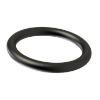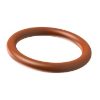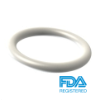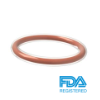O-rings are sealing rings made from various rubbermaterials specifically designed to isolate fluids or gases and prevent leakage. These Materials play an essential role in diverse sealing applications across industries such as automotive, chemical processing, machinery, and more.
Each of these rubbermaterials is a type of polymer produced by polymerizing specific monomers. Selecting the right rubber material for an O-ring is crucial and depends on factors such as application temperature, chemical compatibility, and mechanical load. A thorough understanding of these materials' properties is essential for designing and selecting effective sealing solutions.
NBR - Nitrile Rubber
NBR (Nitrile Rubber) is a synthetic rubber material known for its excellent resistance to oils, greases, and fuels, making it widely used in the automotive industry, hydraulic systems, and mechanical seals. In addition to chemical resistance, NBR materials also offer good mechanical properties such as resistance to wear, tear, and compression. These properties make NBR O-rings durable and reliable for use in demanding environments.
The flexibility of NBR materials makes them suitable for sealing applications where a tight seal is required, even under varying pressure and temperature conditions. NBR O-rings are available in different hardness and sizes, making them versatile for various industries. The combination of chemical resistance and mechanical durability makes NBR a popular choice for O-rings across a wide range of applications.
EPDM (Ethylene Propylene Diene Monomer)
EPDM O-rings are often used for outdoor applications due to their remarkable resistance to weathering, ozone, and UV radiation. What distinguishes these O-rings is their ability to maintain elasticity over an extended temperature range while also resisting steam and water vapor. These properties make EPDM materials particularly suitable for various applications, including HVAC systems, plumbing, and automotive applications.
Due to their excellent resistance to external factors such as sunlight, moisture, and extreme temperatures, EPDM O-rings are reliable choices for sealing applications in both indoor and outdoor environments. The durability and versatility of EPDM materials make them a popular choice across industries where they ensure effective sealing and long-term performance under demanding conditions.
FFKM - Perfluoroelastomer (e.g., Kalrez®)
FFKM O-rings, including the well-known Kalrez brand, are renowned for their exceptional chemical resistance and thermal stability. These O-rings can withstand aggressive chemicals, high temperatures, and extreme conditions, making them an essential choice for demanding industries such as chemical processing and semiconductor fabrication.
The unique ability of FFKM O-rings to perform under extreme conditions makes these materials ideal for applications where other materials fall short. They provide reliable sealing performance and contribute to the integrity of systems exposed to aggressive chemicals and high temperatures up to +340ºC.
Due to their superior properties, FFKM O-rings are a preferred choice in sectors where precision, reliability, and durability are essential for maintaining operational efficiency and safety.
FKM - Fluoroelastomer (e.g., Viton®)
FKM O-rings, including the well-known Viton brand, offer excellent chemical resistance to oils, fuels, and acids. These O-rings can also withstand high temperatures and are resistant to ozone and aging, making them particularly suitable for demanding environments.
The versatility of FKM materials makes them a popular choice across various industries, including oil and gas, automotive, and aerospace. In the oil industry, FKM O-rings are used for seals in engine components and drilling equipment. In the automotive sector, they are found in fuel systems and engine seals. In aerospace, FKM O-rings are used in hydraulic systems and seals for fuel and lubricant lines.
The durability and reliability of FKM materials contribute to safe and efficient performance in critical applications within these industries.
VMQ - Silicone Rubber
VMQ O-rings, also known as silicone rubber, are favored for their wide temperature range, withstanding both very low and high temperatures. Additionally, they offer good flexibility and elasticity, essential for sealing applications.
Another advantage of VMQ materials is their excellent water and UV resistance, making them durable in damp and exposed environments. Because of these properties, VMQ O-rings are widely used in sectors such as medical equipment, food processing, and electrical applications.
It's important to note that silicone rubber is often FDA-approved, meeting the strict standards of the Food and Drug Administration for use in food-related applications. This makes VMQ materials a safe and suitable choice for contact with food and beverages in the food industry. The reliability and versatility of VMQ O-rings make them suitable for a wide range of critical applications where sealing efficiency and durability are crucial for system performance.
PTFE (Polytetrafluoroethylene)
PTFE O-rings, made from polytetrafluoroethylene, offer a unique combination of properties that make them ideal for critical sealing applications. They are known for their low friction, resulting in smooth movements and reduced wear in dynamic seals. Moreover, PTFE materials exhibit excellent chemical resistance to a wide range of aggressive chemicals, making them suitable for use in the chemical industry, pharmaceutical industry, and aerospace.
One of the most notable properties of PTFE O-rings is their ability to withstand high temperatures without degradation of material properties. This makes them suitable for applications where exposure to extreme temperatures is a factor, such as in thermal processes and aerospace applications. The chemical inertness of PTFE materials ensures that they do not react with surrounding media, making them safe for use in critical environments where purity and reliability are essential.
FEP Encapsulated
FEP (Fluorinated Ethylene Propylene) encapsulated O-rings combine the excellent properties of PTFE with enhanced flexibility, making them suitable for various demanding applications. In addition to their chemical resistance and low permeability, FEP O-rings also offer a high degree of flexibility, making them easier to install and apply in complex sealing systems.
These O-rings withstand chemical exposure and can withstand high temperatures, making them suitable for laboratory equipment, electronics, and chemical processing equipment. Their versatility makes FEP materials ideal for applications where both chemical inertness and mechanical performance are required.
Thanks to their properties, FEP materials can enhance performance and extend the lifespan of equipment in critical applications where sealing efficiency is crucial.
HNBR (Hydrogenated Nitrile Rubber)
HNBR (Hydrogenated Nitrile Rubber) O-rings offer significant advantages over standard NBR (Nitrile Rubber), including improved resistance to oils and higher temperatures. This makes HNBR materials ideal for demanding applications in the automotive sector, oil and gas industry, and hydraulic systems.
By adding hydrogen to the NBR polymer, HNBR is characterized by enhanced mechanical properties, increased strength, and improved resistance to aging and heat. This results in better resistance to oils and chemicals, making HNBR O-rings suitable for applications where standard NBR may fall short.
The reliable performance of HNBR materials contributes to the efficiency and durability of systems in critical sectors, where sealing efficiency and reliability are crucial for safe and trouble-free operation.
FEPM (Tetrafluoroethylene Propylene)
FEPM (Tetrafluoroethylene Propylene) O-rings offer an impressive combination of properties, including excellent chemical resistance and thermal stability comparable to those of FKM (Fluoroelastomer). These properties make FEPM O-rings suitable for use in aggressive chemical environments, oils, and high-temperature applications, especially in the chemical and petrochemical industry.
Due to their resistance to chemicals such as acids, bases, and solvents, FEPM materials can maintain the integrity of sealing systems even under extreme conditions. They are designed to provide durability and reliability in demanding environments where sealing efficiency is crucial for the safe operation of equipment and installations.
he versatility and performance of FEPM materials make them a preferred choice for industries relying on robust seals capable of withstanding heavy chemical and thermal loads.
ECO (Epichlorohydrin Rubber)
ECO (Epichlorohydrin) O-rings offer excellent properties for sealing applications requiring resistance to oils, fuels, and ozone. These O-rings are particularly suitable for automotive applications, fuel systems, and seals in the transportation sector, where reliability and durability are crucial.
The unique feature of ECO materials is their ability to withstand various types of fuels, including gasoline, diesel, and biodiesel, as well as oils and lubricants used in vehicles. Additionally, ECO O-rings exhibit excellent ozone resistance, which is essential for outdoor applications where they are exposed to atmospheric conditions.
Due to their versatility and robust properties, ECO materials contribute to the reliability and performance of systems in the automotive and transportation sectors, providing seals that withstand the challenging conditions of automotive applications.
CR - Neoprene (Chloroprene Rubber)
CR (Chloroprene Rubber) O-rings are known for their excellent resistance to ozone, weathering, and aging, making them particularly suitable for outdoor applications where exposure to these elements is inevitable. These O-rings are commonly used in maritime applications, such as seals for boats, pontoons, and offshore installations, where they must withstand saltwater and UV radiation.
Additionally, CR-materials find their application in the construction sector, particularly in seals for building materials and structures exposed to outdoor conditions. The durability and weather resistance of CR materials contribute to the integrity of sealing systems in these critical applications, where reliability and long-term performance are essential for the safety and functionality of structures and equipment.
ACM (Acrylate Rubber)
ACM (Acrylate Rubber) O-rings are known for their excellent heat resistance and resistance to oils and greases, making them ideal for use in automotive applications. These O-rings are commonly used in engine seals and fuel systems, where they must withstand the high temperatures and aggressive chemical environments typical of internal combustion engines.
The heat resistance of ACM materials ensures that they maintain their integrity when exposed to elevated temperatures, which is essential for reliable performance in engine applications. Additionally, ACM O-rings offer good resistance to oils and greases, ensuring durability in environments where lubricants and fuels are present.
Thanks to their robust properties, ACM materials contribute to the reliability and efficiency of vehicle systems, providing seals that withstand the challenging conditions of automotive applications.



